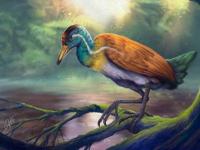100-Million-Year-Old Evidence of Insect Brood Care

A team of scientists from China, Germany, Poland, and the United Kingdom, has described a new genus and species of an ensign scale insect from mid-Cretaceous Burmese amber, which preserves eggs within a wax ovisac, and several freshly hatched nymphs.
“Fossils of fragile female scale insects are extremely rare. What is unique here is the age of the discovery: 100-million-year-old evidence of brood care among insects has not been found until now,” said team leader Dr Bo Wang of the Chinese Academy of Sciences, who is also the lead author of a paper published in the journal eLife.
The fossil, named Wathondara kotejai, is from Kachin Province in northern Myanmar. It is the only Mesozoic (252 to 66 million years ago) record of an adult female scale insect.
“The generic name refers to Wathondara – goddess of earth in Buddhist mythology from Southeast Asia,” Dr Wang and co-authors wrote in the paper.
“The species is named after the late Polish entomologist Jan Koteja in recognition of his significant contribution to the study of both extant and fossil scale insects.”
The 100-million-year-old piece of amber preserves an adult female with eggs, six first-instar nymphs, and a weevil.
“It is polished in the form of a flattened ellipsoid cabochon, clear and transparent, with diameter about 11 mm, height about 5 mm, and weight about 0.8 g.”
Wathondara kotejai was trapped while carrying around 60 eggs and her first freshly hatched nymphs. The eggs and nymphs are encased in a wax-coated egg sac on the abdomen. This primitive form of brood care protects young nymphs from wet and dry conditions and from natural enemies until they have acquired their own thin covering of wax.
The behavior has been so successful for promoting the survival of offspring that it is still common in insects today. Young nymphs hatch inside the egg sac and remain there for a few days before emerging into the outside world.
The findings may even offer an explanation for the early diversification of scale insects.
“Brood care could have been an important driver for the early radiation of scale insects, which occurred during the end of the Jurassic or earliest Cretaceous period during the Mesozoic era,” Dr Wang said.
The only other direct evidence of brood care is from Cenozoic ambers, the era that extends to the present and began about 65 million years ago with the extinction of the dinosaurs.
_____
Bo Wang et al. 2015. Brood care in a 100-million-year-old scale insect. eLife 4: e05447; doi: 10.7554/eLife.05447
Source: www.sci-news.com








